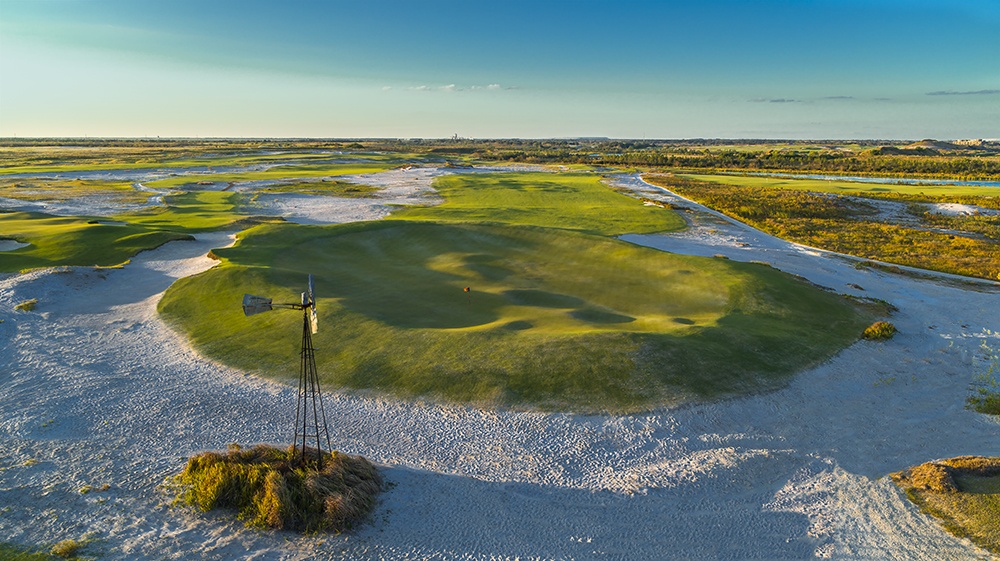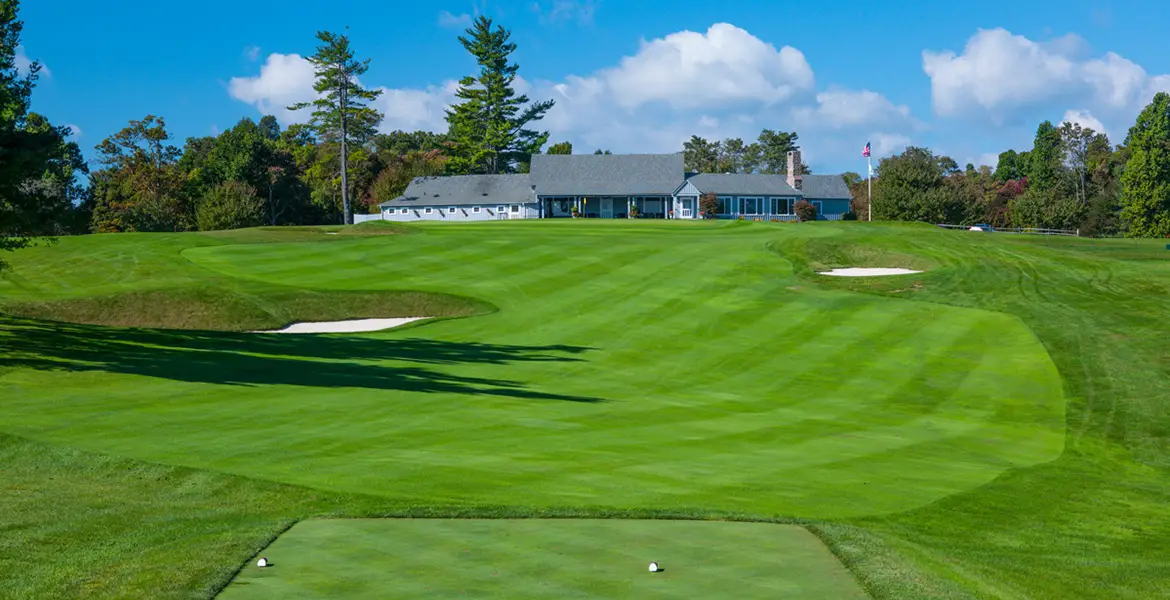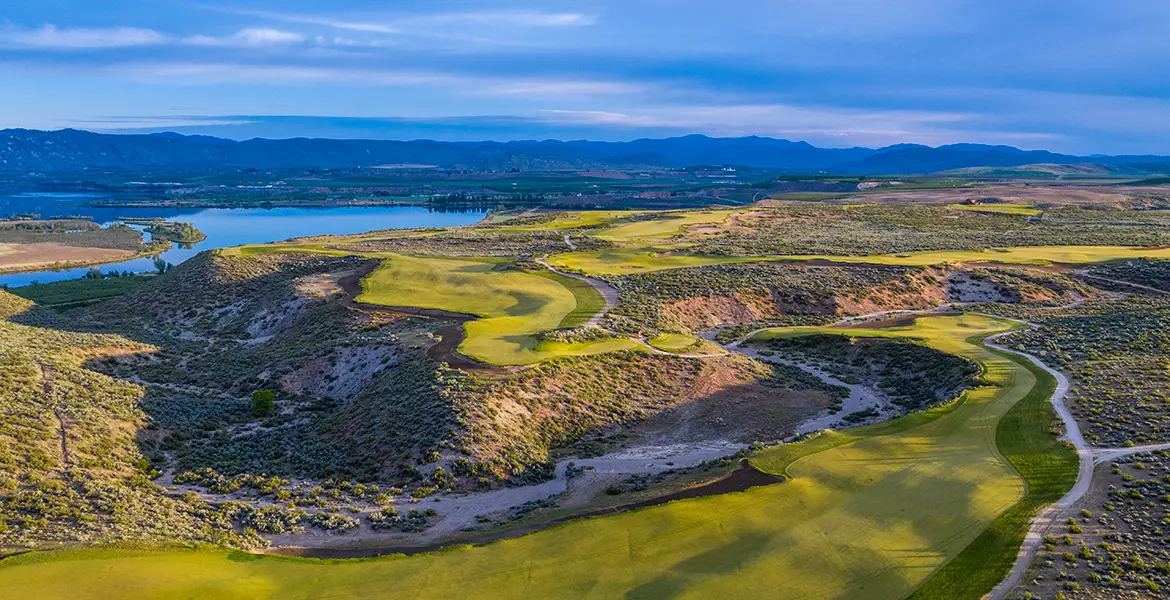There’s something to be said for the anticipation created by an approach shot into a Punchbowl green—some golfers love it… others, not so much.
The Punchbowl is one of golf’s best known template holes: A green surrounded by mounding that gives it a bowl shape and funnels balls toward the center of the putting surface, even those that are slightly offline. Punchbowl greens gained footing on older links courses in the UK where golf architects identified spots in hollows that were protected by the wind. They’ll vary in shape, size, and overall hole length, but commonly feature a blind approach, leaving golfers to wonder where exactly on the green they’ll find their ball.
More recently, some Punchbowl greens have been built at or above fairway level, at times as a design aesthetic or a way to facilitate drainage. After recently taking a look at another template, the Biarritz, here’s a lineup of some of the top U.S. examples of Punchbowl holes:
National Golf Links (N.Y.)—16th hole
One of the most famous Punchbowls anywhere in the world of golf can be found at this C.B. Macdonald/Seth Raynor masterpiece on Long Island. The par-four 16th hole plays steadily uphill, with a flag atop a tall pole helping direct the target line for the smallish green itself, which is flanked by the club’s unmistakable windmill.

Streamsong Black (Fla.)—9th hole
Gil Hanse put some modern touches on the traditional template at the newest of the three courses at Streamsong, with an enormous putting surface that features four distinct quadrants. A sign on the tee of the par-four 9th shows where the flag is on any given day, but often there’s no telling where a ball will end up after it disappears over the hill and into this gargantuan bowl.

Hackensack Golf Club (N.J.)—16th hole
The par-four 16th hole at this North Jersey club (a Raynor design built by Charles Banks) is a visual stunner, with a hill about eight feet high encircling the green. There’s an opening in front, offering a peek at the flag and putting surface, as well as a delightfully devilish bunker built into the hill on the left side of the green.
The Punchbowl 16th at Hackensack Golf Club, a 1924 Charles Banks design. The club has been restoring the sharpness to Banks’s templates in recent years, and the results thus far have been outstanding. The overall quality of the golf in this area of NJ is absolutely remarkable. pic.twitter.com/ChM7XSX2bE
— LinksGems Golf Photos (@LinksGems) August 4, 2018
Fishers Island (N.Y.)—4th hole
Another Raynor design, the par-four 4th hole boasts a spectacular combo of an Alps feature along with a truly memorable Punchbowl. A drive to a raised fairway leaves players facing a blind shot over a mound, or Alps, to a green that sits about 30 feet below the fairway, ringed by a mound and backed by ocean.

The Creek Club (N.Y.)—6th hole
The par-four 6th at this Long Island gem is also unique, as Raynor and Macdonald incorporated a reverse Redan green (which slopes front to back and falls away to the right) with a lower profile Punchbowl that has a small opening to the green on the front left side. Approach shots here aren’t blind and ideally necessitate a fade, at least from righthanders, to best access the pin.
The Punchbowl par-4 6th at The Creek is one of the most popular requests I get. People just love this rendition of the classic Raynor template, and with good reason – following Gil Hanse’s restoration, it’s one of the best golf holes on Long Island … and beyond. pic.twitter.com/Omh0y6SO1W
— LinksGems Golf Photos (@LinksGems) May 1, 2020
Sand Valley (Wis.)—17th hole
The 17th hole at the Bill Coore and Ben Crenshaw-designed Sand Valley course at the central Wisconsin resort of the same name is a terrific example of a Punchbowl accessible to the public. The uphill par three plays to a green surrounded by bold slopes that funnel the ball toward the putting surface.

Black Creek Club (Tenn.)—6th hole
Brian Silva created a Punchbowl green on the mid-length par-five 6th hole at this Tennessee course, with a lengthy hill about 100 yards out that blocks a player’s view of the green. The hole slopes downhill toward the squared-off green after the hill, with a target pole helping show the desired line of attack for blind shots.
Mountain Lake (Fla.)—15th hole
While not fully blind, you can’t see the putting surface itself on the short par-four 15th hole at Mountain Lake, one of only two remaining Raynor routings in Florida. There’s a notably higher slope on the left side of the green that can be used as a kickboard to funnel balls toward certain pin positions.
#TemplateTuesday – the #Punchbowl at Mountain Lake, like the other templates here, is subtle but expertly rendered pic.twitter.com/PMMDMn9arU
— LinksGems Golf Photos (@LinksGems) August 10, 2016
Essex County Country Club (N.J.)—14th hole
The 14th hole at this North Jersey club built by Raynor and Banks is a shorter, uphill par four that features a Lion’s Mouth bunker as well as a Punchbowl green. There are openings on the front of the green, on either side of the yawning bunker, but it’s a tricky, semi-blind approach that’s uphill all the way.
The fog descends on the Punchbowl green at the 301-yard uphill par-4 14th at Essex County Country Club. The green has many humps and bumps, the most prominent of which runs through the rough and across the putting surface. A fun and unique rendition of this template concept. pic.twitter.com/15StiDgWEB
— LinksGems Golf Photos (@LinksGems) May 19, 2018
St. Louis Country Club (Mo.)—5th hole
Another interesting take on the Punchbowl template, the par-five 5th at St. Louis CC plays downhill but features a blind approach shot to a green that’s backed by a stream.
The par-5 5th at St. Louis Country Club – an Alps/Punchbowl template in the vein of Sleepy Hollow rather than NGLA, Macdonald used a sunken green below fairway level to create the blind Alps effect. Uniquely, the bowled green is backed by a stonewalled burn. A terrific hole. pic.twitter.com/9HXOfurHJ1
— LinksGems Golf Photos (@LinksGems) March 24, 2019
Which of these Punchbowl holes is your favorite? Are there other examples not included here that you like best? If so, why?







Odd that there’s no mention of either the 3rd or 18th at Old Macdonald (Bandon), nor Chambers Bay’s 12th?
Or Wine Valley #7